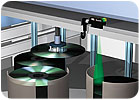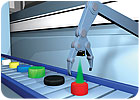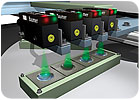Ultrasonic sensors use sound waves to measure distances or detect the presence or absence of objects.


On a conveyorized assembly line, ultrasonic sensors can be used to measure the height of parts. In this illustration, the sensor is integrated into a robotic gripper that removes parts that are too large or too small for the application.
Based on the speed that sound travels through air, ultrasonic sensors measure distance by emitting a characteristic sonic burst, then calculating the time required for the echo to return to the sensor. If the sensor does not hear the echo, it will not activate. While ambient noise will not interfere with their operation, ultrasonic sensors can be affected by high temperatures or strong winds crossing the target area.
The major benefit of ultrasonic sensors is their ability to measure difficult targets. These sensors are not affected by color, transparency or gloss, and object texture has little effect. They can reliably detect solids, liquids, granules or powders, and they are resistant to both dust and light. Transparent and highly reflective items, such as glass and plastic, can cause problems for optical sensors, but they are reliably recognized by ultrasonic technology. Ultrasonic sensors can also be used for distance measurement, continuous control of fluid and granulate levels, and sensing the level of stacked items, such as paper, sheet metal and wood.
Often used for detecting material levels in tanks, ultrasonic sensors are effective even when the devices cannot be mounted directly over or across from the target material. In these cases, the sound waves can be bounced off a flat, hard surface mounted over the tank on a 45-degree angle. The waves then bounce off the substance in the tank and are reflected back to the sensor.
Ultrasonic sensors do have some limitations. Sound-absorbing target materials, such as foam or soft fabrics, are not good candidates for most versions of these sensors. Extremely rough surfaces may diffuse the sound excessively, decreasing range and resolution. And their use for detecting small targets is limited.
These sensors provide excellent long-range object detection, sensing objects greater than 2.5 meters away. Objects within 10 millimeters of the sensor are in the “blind range,” an area where sound waves cannot be accurately detected.
There is no limit to the maximum size of the target an ultrasonic sensor can detect-cars and elephants are not too big. While no exact minimum object size can be accurately forecast, ultrasonic sensors are tested to a standard object size of 15 square millimeters-roughly the size of a dime-for sensing distances to 250 millimeters.
Extremely small targets may not reflect a signal strong enough to ensure reliable detection. With small targets, there is also an increased chance of receiving feedback from interfering objects. Some ultrasonic sensors are available with sonic cone angles as narrow as 6 degrees, allowing the detection of small objects and targets located in narrow areas such as bottle necks, pipes and ampoules.

In this packaging application, ultrasonic sensors are used to confirm the presence of wetting solution in contact lens packages. The color of the contact or solution will not affect the sensor’s results.
Sensor Styles
Ultrasonic sensors are available in three styles: diffuse proximity, retroreflective and through-beam versions. Ultrasonic diffuse proximity sensors have a special sonic transducer that alternately transmits and receives sound waves. The transducer emits a series of sonic pulses and then listens for their return as they are reflected from the target. Once the reflected signal is received, the sensor signals an output to a control device, such as a PLC.The sensitivity of diffuse proximity sensors, defined as the time window for listen vs. send cycles, may be adjusted via a teach-in button or a potentiometer. While standard diffuse ultrasonic sensors will give simple presence or absence of target information, analog versions can actually measure the distance. Their output of 4 to 20 milliamps or 0 to 10 volts can easily be converted into useable distance information.
Ultrasonic retroreflective sensors detect objects within a specified sensing distance by measuring propagation time. The sensor emits a series of sonic pulses that bounce off of a fixed opposing reflector. The reflector can be any flat, hard surface, such as a piece of machinery or a board. The sound waves must return to the sensor within a fixed, user-adjusted time interval. The sensor signals an output if that time interval changes due to an obstructing object in its sensing path. As the sensor is listening for any change in propagation time instead of a returned signal, it can be used on sound-absorbent and sound-deflecting materials. The diffuse style of ultrasonic sensor would have limitations with these materials, because they would not reliability return the pulsed sound.
Unlike diffuse proximity and retroreflective models, ultrasonic through-beam sensors separate the emitter and receiver housings. The emitter sends a continuous signal, which is then picked up by the receiver. When an object disrupts the sonic beam, the receiver reacts and triggers an output. These sensors are ideal in applications that require the detection of a continuous object, such as a web of clear plastic. If the clear plastic breaks, the output of the sensor will trigger the PLC.